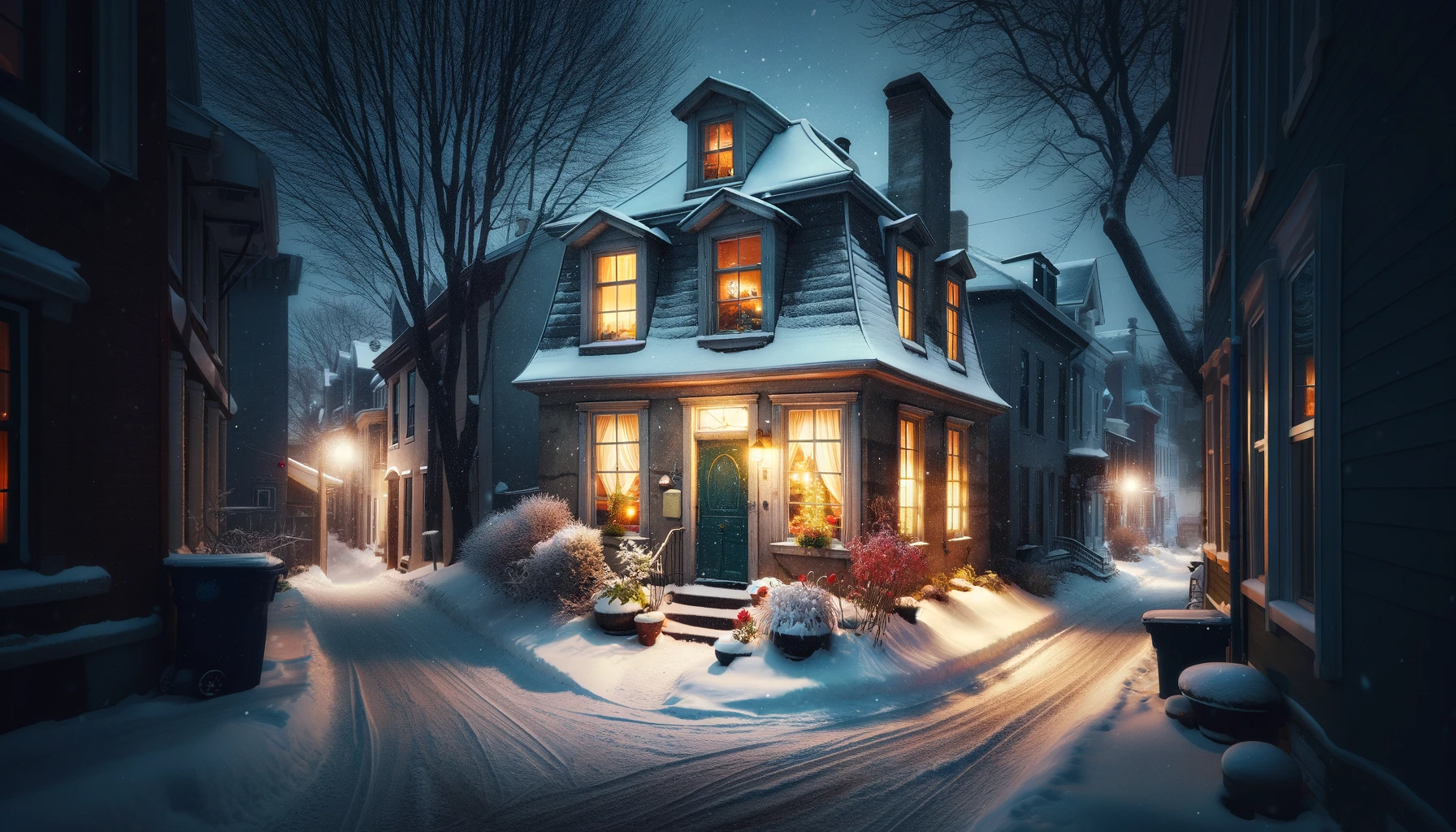In a small, forgotten town, where the chill of winter never seemed to lift, there was a house at the end of a dimly lit street. It stood there, somewhat crooked, its paint peeling, a testament to better days long gone. Inside lived an old man, his eyes as grey as the skies above, his hands, once strong and steady, now trembled with the weight of years.
The town had forgotten the old man, much like it had forgotten the joy of seasons changing. Here, the winter was eternal, the snow an unending dance against the windows of the houses. In the old man’s home, the only sound was the gentle tapping of snowflakes against the glass, a melancholy rhythm that echoed through the empty rooms.
Each day, the old man would sit by the window, watching the snow dance. His thoughts often drifted to his youth, to days filled with laughter and warmth, now just fading echoes in his memory. The snowflakes, swirling in the cold wind, seemed to him like lost spirits, wandering aimlessly in the endless white.
The town, once vibrant and full of life, had slowly succumbed to the unyielding grip of winter. The people who remained were like shadows, moving silently through the snow-covered streets, their faces hidden beneath layers of clothing, their hearts as cold as the ice that encased their world.
In his solitude, the old man found a strange comfort in the snow. It was his constant companion, the only thing that remained unchanged in a world that had left him behind. He often wondered if the snowflakes were messengers, carrying secrets from another time, a time when he was young, and the world was full of possibilities.
As the days turned into weeks, and the weeks into months, the old man’s health began to fail. The cold seeped into his bones, a relentless reminder of the passing of time. Yet, he remained by the window, his gaze fixed on the eternal dance of the snowflakes.
One quiet evening, as the sky turned a deep shade of twilight blue, the old man closed his eyes for the last time. The snow continued to fall, each flake a silent witness to the end of a life that had once been full of color and light.
And so, the house at the end of the street stood even more alone, its windows still framing the endless dance of the snow, a dance that would continue long after the memories of the old man had faded into the winter’s embrace.
In the days that followed, the town seemed even more silent, if that were possible. The news of the old man’s passing spread quietly, like a whisper on the wind. Few remembered him, and even fewer mourned. But the house at the end of the street, with its peeling paint and its windows full of dancing snow, stood as a silent testament to his existence.
Winter deepened its hold on the town, the snow piling higher and higher, covering the streets in a thick, white blanket. The people, already accustomed to the cold and isolation, carried on with their lives, their routines unaltered by the loss of one of their own.
But in the house, something had changed. Where there had once been a presence, a feeling of life, however faint, there was now only emptiness. The rooms felt colder, the shadows deeper. The snow continued to tap against the window, but there was no one to watch, no one to listen.
Then, one night, as the moon hung low in the sky, casting a pale light over the snow-covered town, a figure appeared at the house. It was a young woman, her face hidden beneath a hood, her steps hesitant as she approached the front door. She had heard stories of the old man, tales of a life lived in solitude, of a heart grown cold with loneliness.
Curiosity had brought her here, to this forgotten house at the end of the street. She pushed open the door, which creaked loudly in the silent night. Stepping inside, she felt a chill run down her spine, not just from the cold, but from the feeling of stepping into a place lost in time.
As she wandered through the rooms, her footsteps echoing in the empty space, she could almost sense the old man’s presence. She imagined him sitting by the window, watching the snow, lost in his thoughts. The house, with its faded wallpaper and dusty furniture, felt like a capsule, a piece of history untouched by the passing years.
Drawn to the window, the young woman looked out at the snow, now illuminated by the moon’s silver light. It danced and swirled, as if performing just for her. In that moment, she felt a connection to the old man, a understanding of his fascination with the winter’s ballet.
She stayed there for a long time, watching the snow, thinking about the old man and the life he had lived. When she finally left, the first light of dawn was breaking on the horizon, casting a soft glow on the snow.
The house at the end of the street returned to its silence, but something had changed. The old man’s memory, once fading, was now rekindled in the heart of someone who had seen the beauty in his solitary world. And outside, the snow kept dancing, a never-ending dance of beauty and melancholy, beneath the watchful eyes of the winter sky.
The young woman, whose encounter with the old man’s world had stirred something deep within her, found herself drawn back to the house time and again. With each visit, she brought something new – a candle, a picture, a book. Bit by bit, she started to fill the empty rooms with traces of life, as though in doing so, she could somehow bridge the gap between the past and the present.
The townspeople began to notice the change. Lights appeared in the windows of the old house, casting a warm glow against the perpetual snowfall. Smoke curled from the chimney, a sign that the hearth had been rekindled after years of coldness. Whispers started to spread through the town, whispers of the house at the end of the street coming back to life.
As winter gave way to the hesitant bloom of spring, the young woman continued her work. She tended to the neglected garden, coaxing it back to life with tender care. Flowers bloomed, their colors a stark contrast to the endless white of the previous months. The house itself seemed to respond, its walls and floors absorbing the new warmth, its creaks and groans sounding less like the laments of old age and more like the settling of contentment.
The story of the old man and the young woman who had brought his house back to life became a beacon of hope in the town. People who had once shunned the house now stopped by, offering gifts and help. The house became a gathering place, a symbol of community and renewal in a town that had long forgotten the meaning of both.
As the seasons changed, the young woman felt a deep connection to the house and the legacy of the old man. She often sat by the same window where he had spent his final days, watching the dance of the seasons. She realized that the house was not just a structure of wood and stone, but a keeper of stories, a guardian of memories.
Years passed, and the young woman grew older. The house, once a symbol of decay, now stood proudly as a testament to resilience and care. It had become a part of her, just as she had become a part of it. The townspeople, too, had changed. Where once there was isolation and indifference, there was now a sense of community, a warmth that extended beyond the walls of the old house.
In the end, the old man’s legacy was not one of loneliness, but of connection. Through the young woman’s efforts, his memory lived on, not as a shadow of the past, but as a beacon for the future. And outside, the snow continued to dance, no longer a symbol of endless winter, but a celebration of the ever-changing tapestry of life.

